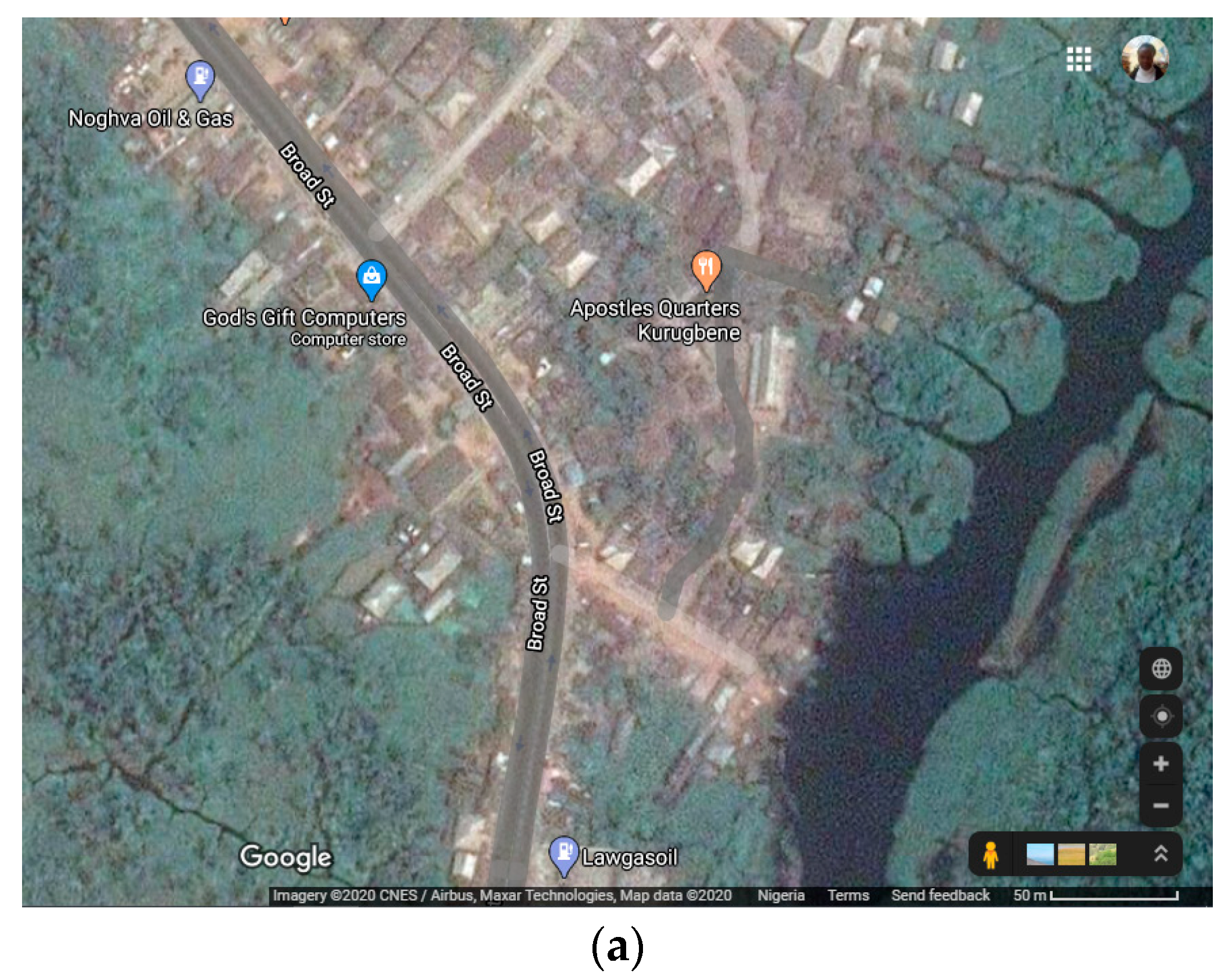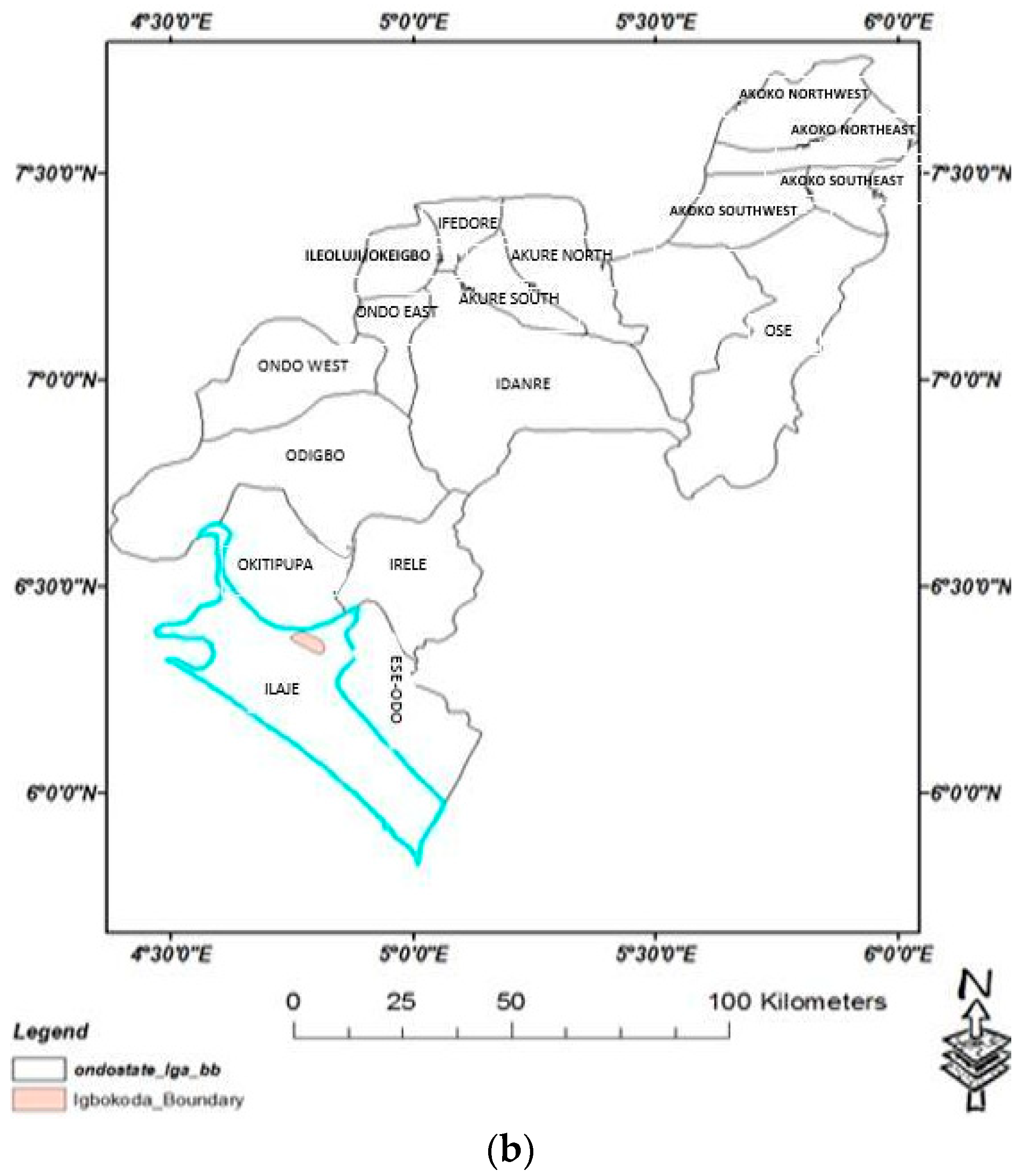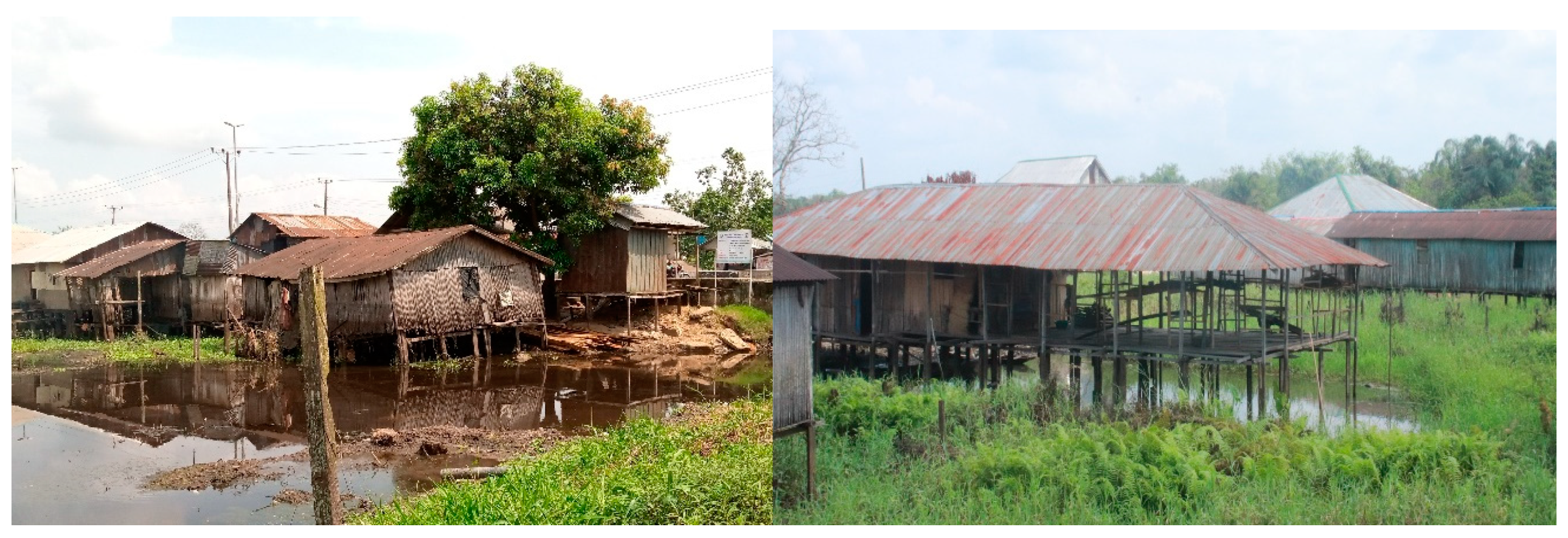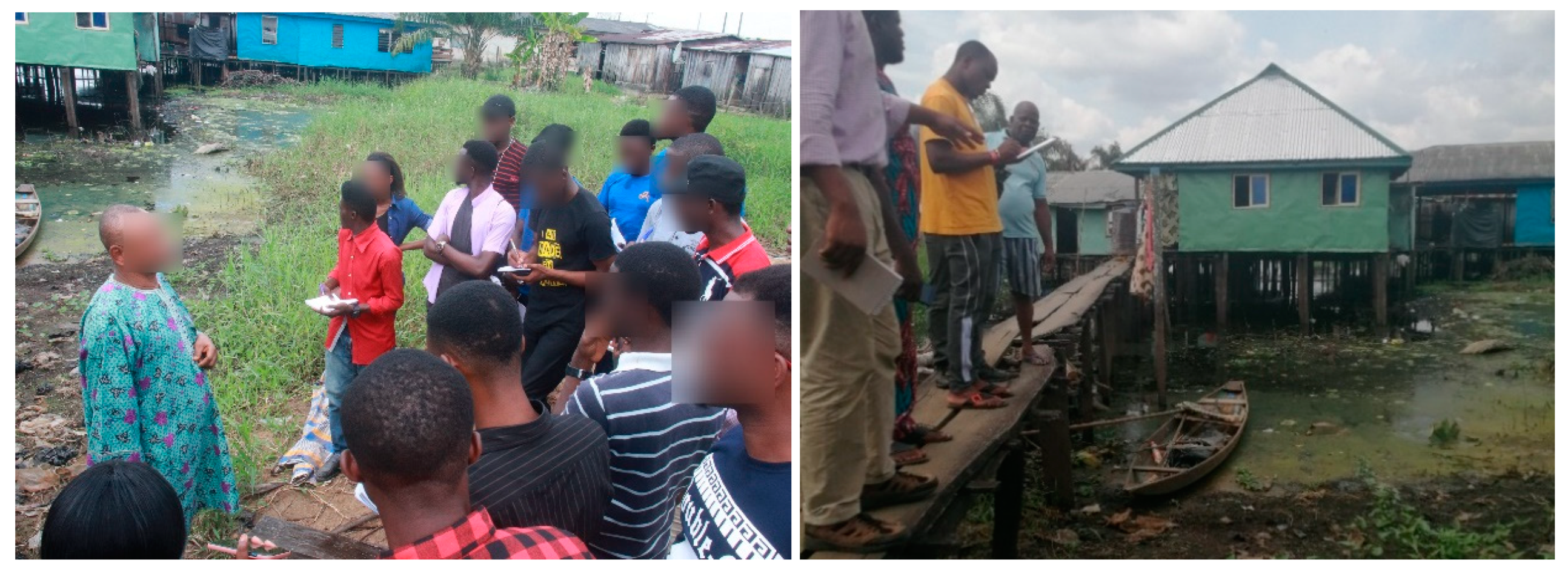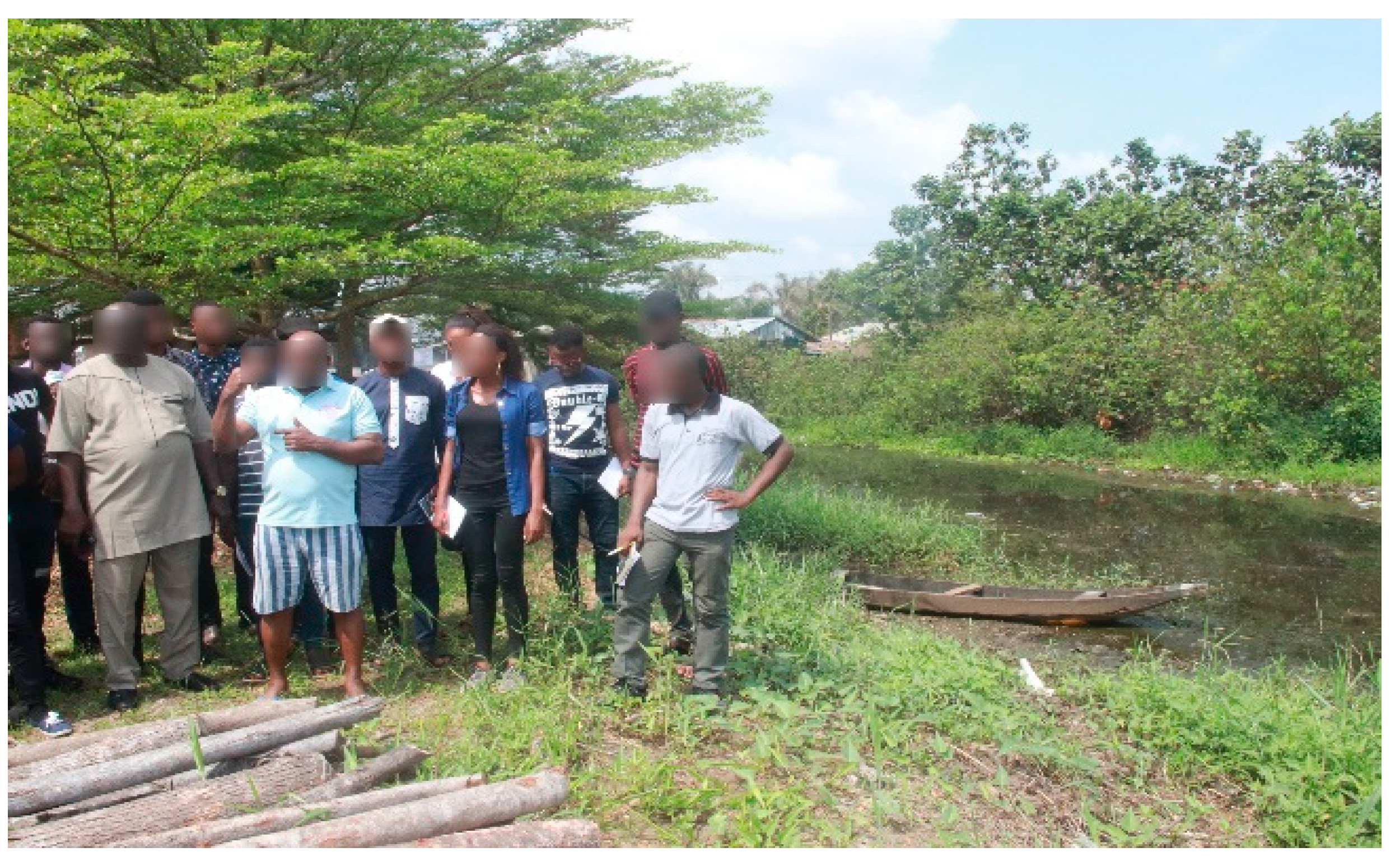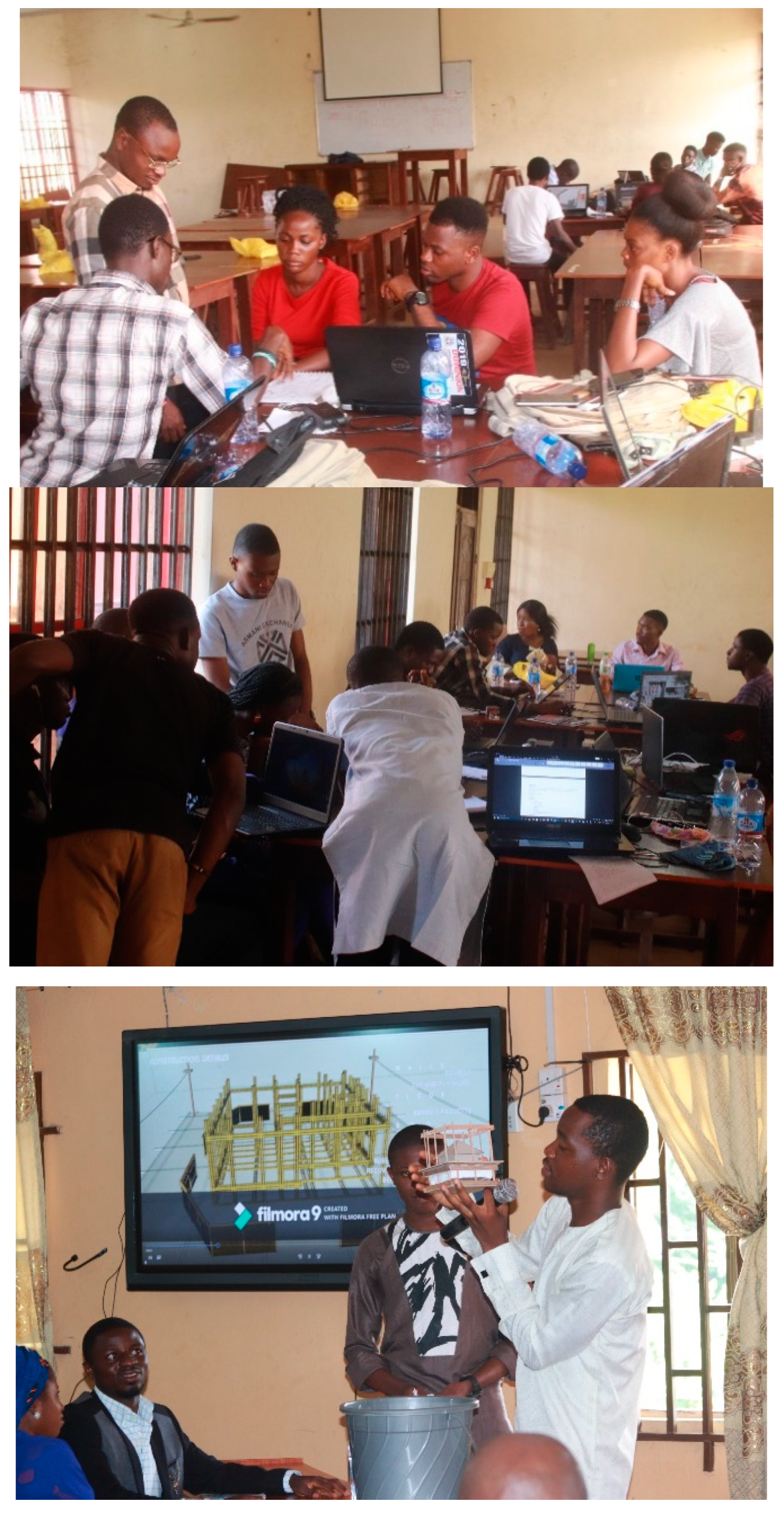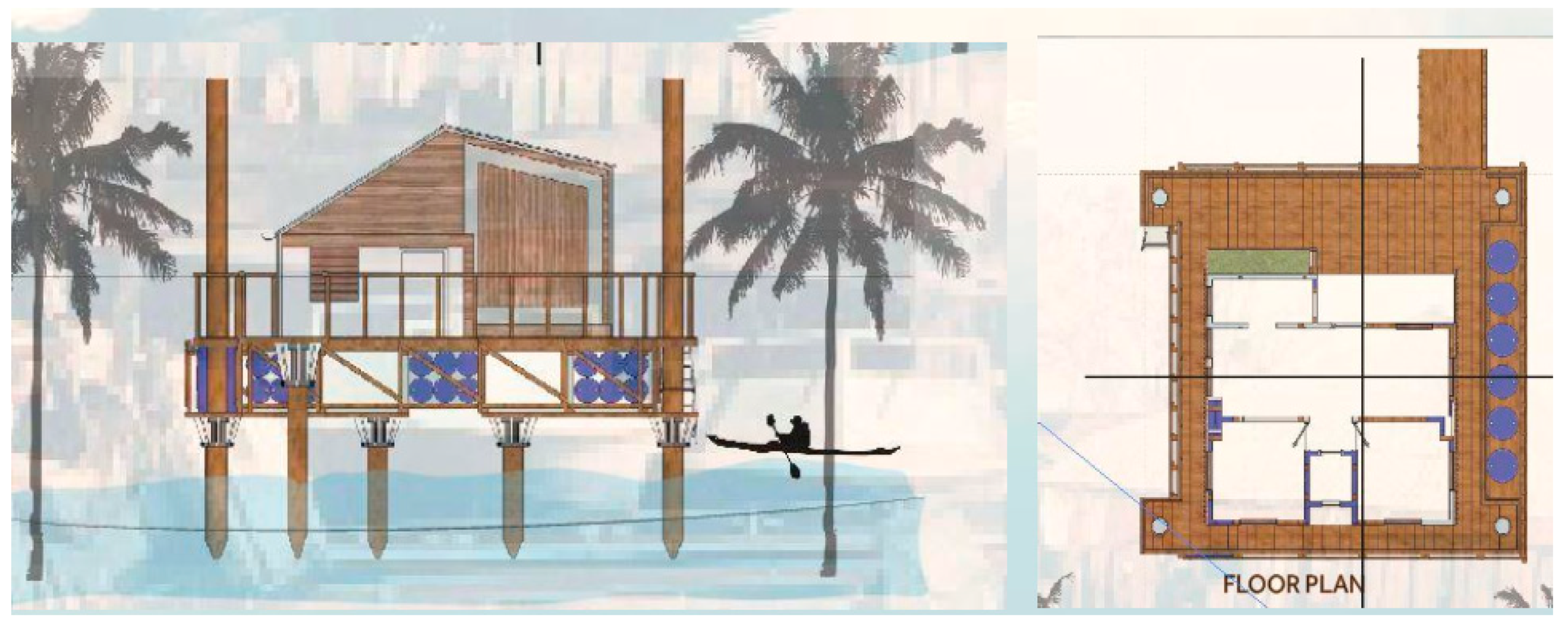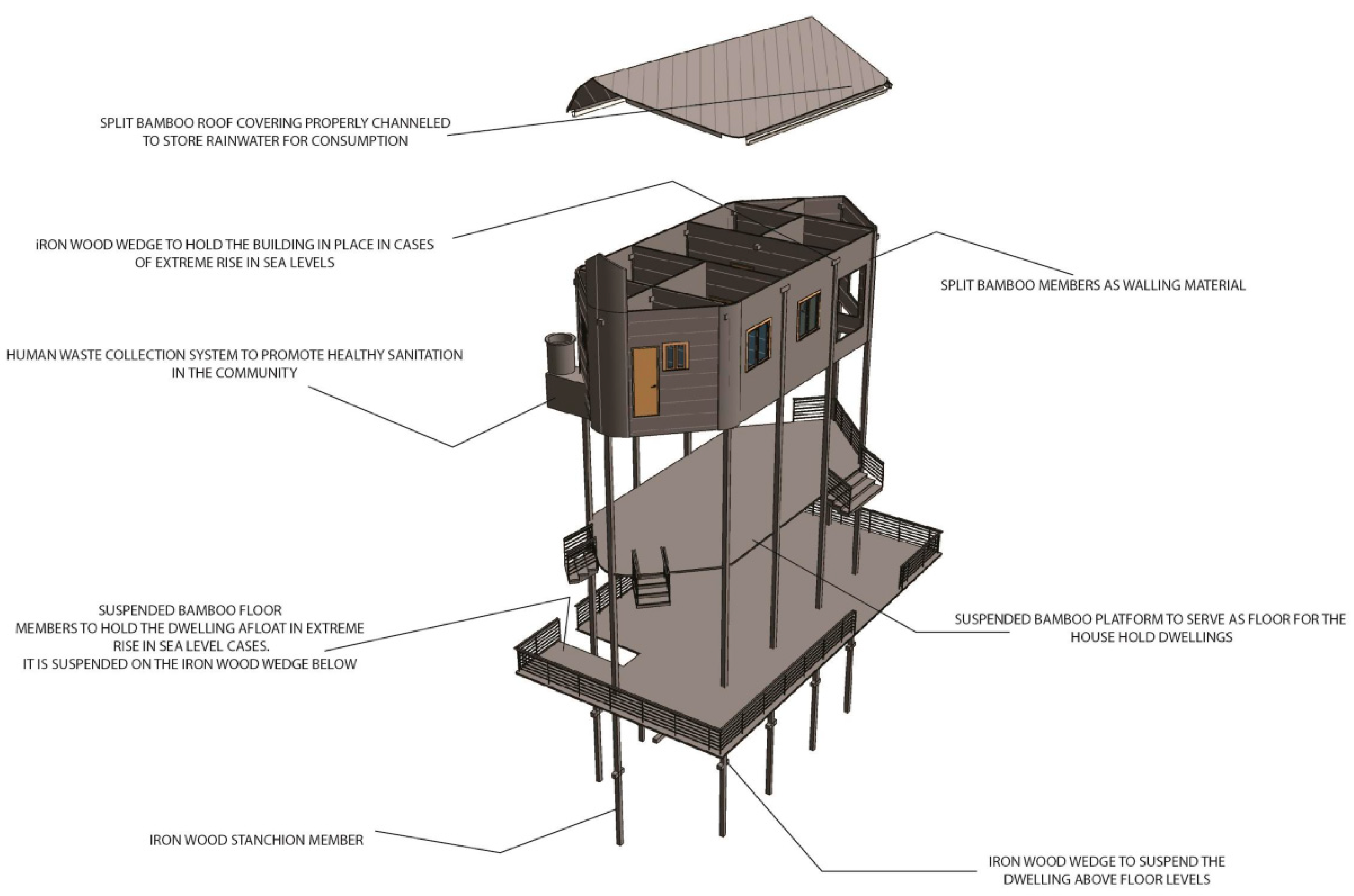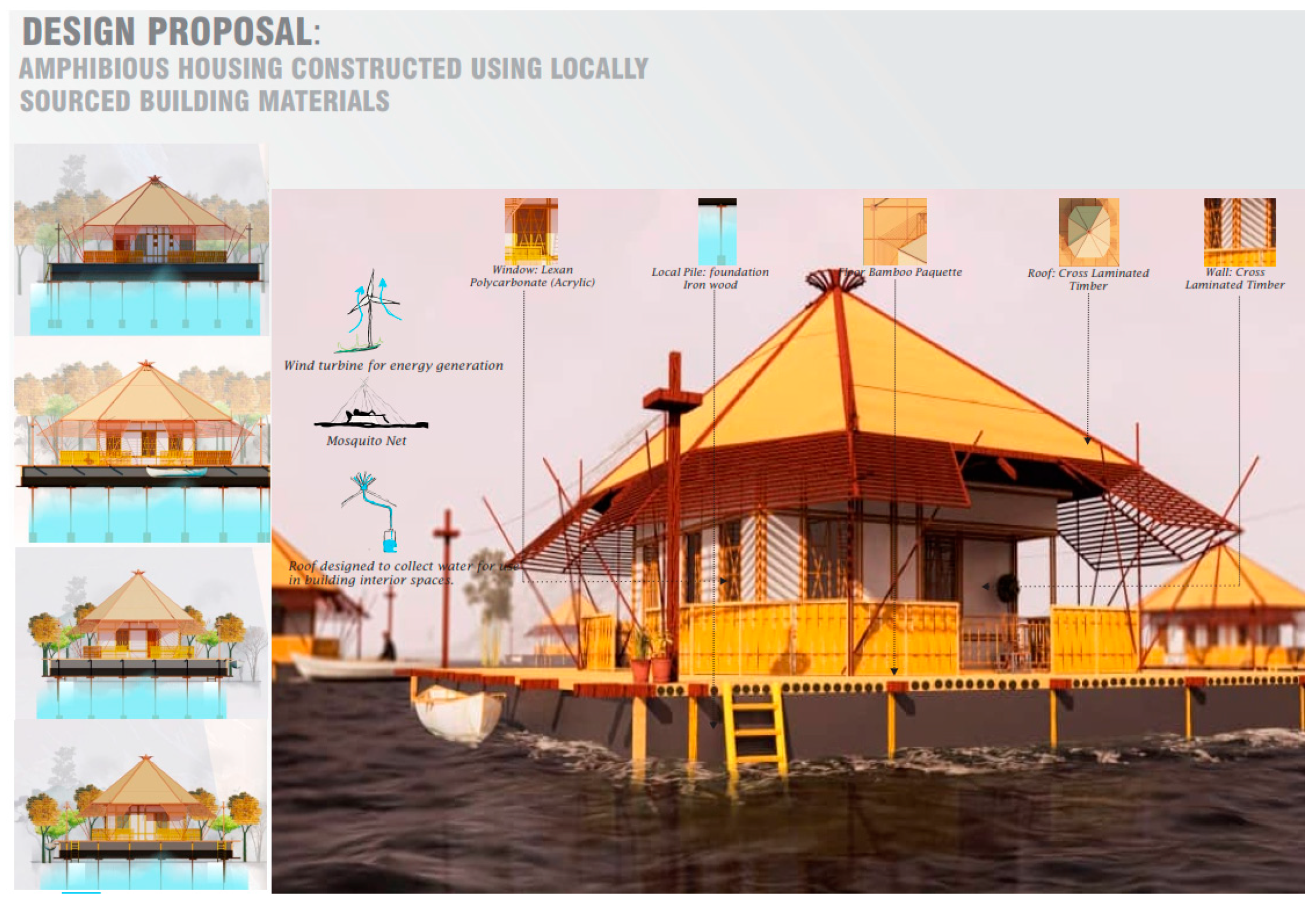1. Introduction
Climate risks are concentrated in low-income urban settlements, especially those within coastal zones. Impacts such as sea level rise, flooding, and heat stress associated with extreme weather events are becoming common, negatively affecting lives, natural ecosystems, and the built environment [
1,
2]. Poor households within low-income settlements in developing countries are more vulnerable to these impacts, which involve livelihood stress, health hazards, and social and physical constraints affecting housing and infrastructure [
3,
4]. With urbanization and continued utilization of the coastal zone for human settlements, the need for climate adaptation and resilience is paramount.
The role of design education and practice in collaboratively promoting principles that address climate-related issues of low-income human settlements is significant. It is being explored globally. This informed a design workshop/charette intended to build the capacity of young professionals in addressing climate impacts and developing workable solutions that can be taken further by relevant stakeholders to resolve developmental challenges. A neighborhood within the coastal town of Igbokoda in Ondo State, Nigeria was the focus during the workshop. Nigeria’s coastal zones cannot be overlooked because a significant portion of the nation’s revenue is derived from oil wells located in the coastal Niger Delta areas.
The purpose of the paper is to report and draw lessons from the design workshop/charette as a unique approach towards evolving sustainable built and natural environments. Through this, the paper contributes to knowledge that further affirms the value of collaborative designs. This paper begins with a literature review that provides a theoretical underpinning and justification. Through examples from literature, it shows why the design workshop/charrette is a suitable approach. Information about the field work context (study area) is provided before a description of the process and some of the design workshop’s outcomes. The paper closes with a reflection on the contributions and some drawbacks, ultimately drawing lessons for co-production of solutions through design education/practice within an era of changing climate.
2. Literature Review/Theoretical Background
Collaborative engagements are becoming popular in addressing challenges associated with climate change. Scholars [
5,
6] have advocated for transdisciplinary approaches, that is, fostering collaboration by moving across disciplinary, sectoral, and stakeholder siloes. This approach has the advantage of generating usable knowledge (much more than mere new knowledge) for the intertwined complex challenges related to global climate change. It has been recognized that informing climate adaptation policy and practice requires learning—a form of learning (understood as doing) which is collective in nature [
7]. There are potentials in social learning and participation. In this situation, social learning implies that “learning occurs through situated and collective engagement with others (i.e., a form of praxis)” (ibid: 370).
In line with the growing recognition for collaborative endeavors, methodologies based on collective engagements are becoming a notable approach for exploring solutions to climate change. Within the design and spatial planning disciplines/professions, workshops (also described as charettes) based on collective engagement have been held. These generally focus on co-producing knowledge, finding solutions, and envisioning the future in relation to climate adaptation and mitigation. Although they initially emerged as an innovative approach to design education and later in practice [
8], design workshops/charrettes are now becoming one of the reliable means of envisioning the future in the complex context of sustainability and climate change [
9]. The roles they play straddle tangible (technical/skill development, capacity building) and intangible (how information is generated and processed) aspects [
10]. The potential contribution to policy formulation at the local level has also been recognized [
11].
Literature contains reports on design workshops/charettes that have taken place in response to climate change and environmental sustainability challenges. Stevenson and colleagues reported a series of “Designs on the Planet” workshops held in UK universities between 2008 and 2009 [
12]. The workshops sought to catalyze design studio teaching strategies in relation to climate change issues, thus contributing to the development of environmental responsibility in practice and pedagogy of architecture. In the same vein, in 2011, the University of Oviedo (Spain) ran weekly workshops that were open to different stakeholders (companies, students, etc.) interested in eco-design issues [
13]. The workshops sought to bring students and companies together, allowing companies opportunities for innovation in eco-design while easing students’ access into the business world.
Within the report given by Jeroen de Waegemaeker’s team in Antwerp (Belgium) are useful lessons from the international design workshop on drought in Flanders (Belgium), Shifting Climate, Reshaping Urban Landscapes (SCRUL), held in the summer of 2015 [
11]. The 24 international workshop participants were drawn from the spatial/design disciplines. The authors acknowledge the design workshop’s advantage in terms of facilitating integrated approaches, but note that more extensive interaction with stakeholders in the policy domain and climate experts is needed for more impactful collaborative processes and outcomes. Another example comes from the “Visions and Pathways 2040” project in Australia. There, design visioning helped to innovate on strategies and policies for a low-carbon, resilient urban future in Australia [
14]. Design charettes, visioning workshops, and stakeholder conversations led to the identification of critical opinion differences on components of a low-carbon, resilient future among various stakeholders and the potentials of emerging innovations. The design charette held helped to integrate insights from desktop research and visioning workshops into images representing “critical moments or artefacts of low-carbon, resilient futures” (ibid: 1919).
Design workshops, also called community studios, held within local communities have been used by human settlement experts in crafting developmental plans and initiatives for slums and informal settlements in developing countries. There are examples from the Ruimsig [
15] and Kya Sands [
16] settlements in Johannesburg, South Africa, as well as the Huruma settlement in Nairobi, Kenya [
17]. The examples from within sub-Saharan Africa are mainly associated with the works of the international NGO Shack Dwellers International (SDI) and affiliate organizations. So far, they usually aim at gathering community inputs for physical development projects, not primarily for climate adaption or resilience. No study reporting these kinds of design workshops/charettes ordinarily or in relation to climate issues in Nigeria was found in the literature accessed. This gives a sense that efforts being made to deal with climate change challenges in human settlements exclude design visioning methodologies rooted in collective engagements. The design workshop/charette reported in this paper is therefore, arguably, novel within Nigeria. It thus fills a gap in terms of the design approach and knowledge gap.
3. Study Area
The design workshop/charette reported was conceived to address challenges and generate solutions using the context of a neighborhood within Igbokoda, a notable coastal town in Ondo State (see
Figure 1). Igbokoda is the headquarters of the Ilaje local government area, located in the southern part of Ondo State, Nigeria. Estimates from the 2006 population census indicate that it presently contains around 170,123,740 persons. It lies from latitude 6′10″ N to 6′25″ N and longitude 4′39″ E to 4′53″ E, covering the coastal sand bars that stretch in a northwest–southeast direction from Okitipupa to the Atlantic Ocean. The terrestrial parts of Igbokoda are about 8–10 m above sea level. The average annual temperature is 27 ºC, with a precipitation average of 2030 mm [
18]. Fishing is one of the main occupations in Igbokoda. Other water-based activities, like boat building, net making/mending, and trading that supports the fishing industry, are common.
Dwellings in coastal settlement areas are unique and remarkably different from those on the mainland. Foundations of waterfront dwellings in Igbokoda, like other coastal settlements, are constructed on raised plinths or wooden piles made of ironwood (called
omoghen in the local language) (see
Figure 2). Ironwood is well known for its durability and strength, reportedly lasting up to 150 years for foundations (piles) of houses on stilts. Building envelopes are constructed using hard wood as structural members, which are eventually cladded with palm fronds, aluminum sheets, or plywood panels, depending on the house owner’s preference or financial ability. Wood is also used for the roof’s structural members in the predominant hip and gable roof style. Aluminum sheets are used for the roof covering.
Like most urban communities in the coastal Niger Delta region of Nigeria, challenges such as flooding, windstorms, and sea level rise—associated with climate change—are palpable in Igbokoda. A recent study in the area showed that flooding is ranked as the most severe environmental problem [
19]. The present flimsy condition of many dwellings in this area shows why low-income settlements are vulnerable to climate change. For example, during the rainy season, there is an increase in water levels, which may reach or supersede the building’s floor levels. With the absence of a ceiling, the roof’s covering material poses health risks because solar radiation is absorbed by the zinc or aluminum sheets, culminating in heat stress. Poor sanitation and wastewater management in the buildings have led to sewage pollution in the water bodies.
These situations are exacerbated by the inadequacy of basic services and the poor infrastructure. For instance, poor waste collection services have resulted in refuse dumping in the water or in drainage, where available. The broad street axis in Igbokoda (see
Figure 1), which was used as the context in the design workshop/charette, embodies these challenges. These impacts and implications for spatial planning, building, and urban design initiatives have been highlighted by many scholars [
20,
21].
4. Design Workshop Process
The design workshop/charette was held as one of the activities within the Climate Research for Development (CR4D) project hosted within the Department of Architecture, Federal University of Technology, Akure, Nigeria. The CR4D team made an open call for participants from the entirety of young people (recent graduates) in the fields of architecture, urban planning/design, and civil/environmental engineering. Of all the participants who responded to the call, 26 applicants were selected based on their motivation, academic and design competence, professional goals, and availability for full participation in the five-day workshop.
After sessions featuring expert talks that provided an introduction and background to the theme being considered were held on the first day, the workshop participants were divided into four groups. The groups were formed with due consideration to the proper mix of disciplines, backgrounds, and gender. Field work, during which group members and some stakeholders met with residents, household heads, and community leaders in the broad street axis of Igbokoda, took place (see
Figure 3). The field work was performed to discuss challenges facing the community, especially flooding/sea level rise, and how they cope with and address these through locally available resources and technologies.
On the last (fifth) day of the workshop/charette, the four teams presented their proposals and strategies (highlighted in the next section) to an audience comprising senior professionals, academics, state officials, and representatives from coastal settlements (see
Figure 4). Innovations, possible implementation strategies, and shortcomings of the proposals emerged through deliberations and feedback that followed the presentations.
5. Strategies for Resilient Housing in Coastal Settlements
The groups made proposals to tackle different problems in the coastal areas. With reference to the study area (Igbokoda), structural and non-structural strategies were proposed. The structural strategies can be further classified into building and non-building proposals. What is shown in this section is a selection from the presentations. The selection addresses climate-related and non-climate-related environmental problems, such as flooding/sea level rise, waste (solid and liquid) management, pollution, water resources, heat stress, and energy access.
5.1. Structural Strategies
The four teams’ building-related proposals focused on low-income housing that is environmentally sustainable and suited to the challenges within coastal areas in an era of climate change (see
Figure 5,
Figure 6 and
Figure 7). The main idea is to ensure that buildings are safe during periods of heavy rainfall, strong winds, and rising sea level. Building construction methods involving a combination of
pilotis and a floating mechanism stacked together in a monolithic manner, developed using locally sourced materials, were explored. Long-lasting ironwood called
omoghen, which is the readily available and popular structural member used by households in housing construction, was further incorporated. Bamboo, which is another locally available material, was creatively incorporated for the buildings.
Notably, in the proposal shown in
Figure 7, ironwood forms the skeleton that holds the building in position. While doing this, it allows other elements to move in an upward or downward position depending on the water/sea level. The proposal shown in
Figure 5 sought to promote proper waste management towards a circular economy; not less than 30 used PET bottles are to be submitted in exchange for barrels to be used in constructing the house. Other sustainable practices for building construction include a special kind of roof design (see
Figure 6;
Figure 7) to aid water collection for its domestic re-use within the house, a small turbine on the roof for energy generation by tapping into the wind speed along the coast, and the use of timber for the walls and floor.
5.2. Non-Structural Strategies
The teams proposed non-structural interventions to solve issues relating to waste disposal and sewage management, livelihoods and employment, waterborne diseases and environmental health, poor sanitation, and so on. These include social and informative measures, legislative controls, and economic instruments. They primarily support the proposed structural strategies for sustainable, resilient housing and built environments.
Concerning solid waste management, a system that involves the use of litter wheel bins located in each cluster of houses (see
Figure 5,
Figure 6 and
Figure 7) was proposed. The typical domestic waste includes food waste, paper/cardboard, rubber/leather, cloth, wood, metal, glass, and others. The collected waste would be sorted, and the part of it that is not reusable/recyclable on water would be transferred to land. Organic waste would feed into biogas production.
Concerning sewage disposal, a central sewer system was designed for the collection of toilet and kitchen waste and for their treatment through an anaerobic process. This process would lead to the production of biogas, which can be used as energy for cooking and other domestic activities. In addition, the bio-solids obtained can be used or sold as fertilizer for farming on land or processed for hydroponic farming.
Other interventions to reduce indiscriminate disposal of plastic waste included the exchange of plastic bottles for toilet services. For instance, plastic materials/bottles, collected from users of community toilets, would be later sold off for recycling purposes. This approach solves two important issues: First, people have access to decent sanitation facilities, discouraging open defecation. Secondly, PET bottles and plastics that damage aquatic life and the marine environment are taken out of the environment. Community-based organizations (CBOs) in the coastal areas are the best suited to manage this kind of initiative.
6. Reflection: Workshop Proposals for a Climate Solution?
The proposals were well received by the workshop audience, who generally appreciated the possibility that housing in a coastal settlement can be safe as well as aesthetically pleasing. It was echoed that adapting some of the ideas for future housing construction can bring an end to perennial flooding problems during the rainy season in the coastal areas. A government official in the audience found the innovations useful and achievable, especially with the use of locally available materials. He promised to present them to the overall director and see how things can take off from there.
The capacity-building goal of the design workshop/charette was achieved. The workshop exposed the young professionals to a new context for design. Most of the participants were seeing and learning to work with new materials, site conditions, and climatic implications in a coastal context for the first time. This affirms the outcome of an experiment by Walker and Seymour [
22], who showed that actively engaging trainee designers (students) in interdisciplinary, service-oriented projects is of value to sustainability in higher education.
Another positive corollary in terms of capacity development is deepened community engagement. Extended interactions among workshop participants—between young designers, local community actors, and institutional stakeholders—provided a platform to cross-pollinate ideas that inform the co-production of solutions that can work for the good of all now and into the future. Overall, the young designers will grow up to become professionals who are better prepared to address present and future challenges in the coastal zones of Nigeria.
There were some criticisms of and drawbacks to the workshop’s process and content. During the presentations, a senior professional (coastal planning expert) quibbled, asking why people should continue to live on water bodies, given the projected future climate-related challenges. Another professional (an architect) advised that the proposals needed to be adequately simulated under extreme weather conditions, as recent events have shown, that Igbokoda is experiencing, for example, very high rainfall patterns that have not occurred before. Another notable comment from a senior professional was that affordability issues were not adequately considered in some of the proposals. Some of the ideas were criticized as being essentially high-tech, which poor households and communities cannot single-handedly afford initially or continuously. These comments deserve consideration for possible future iterations of the workshop’s outputs.
The proposals could not be grounded within the bigger policy of the state or regional development plans. Post-workshop initiatives—presenting the discussion content and proposals from the workshop for the use of wider stakeholder bases within the respective organizations—seek to address this. Since local communities alone cannot handle these themselves, extending linkages with additional stakeholders for the proposals’ refinement and uptake is desired. The under-guiding idea is that the design workshop/charrette, as a model of participation and creativity, involves inclusive and holistic engagements that result in genuine collaboration, not mere consultation between different stakeholders [
23].
The workshop exposed fault lines among professionals/disciplines in the built environment. It appears that working together—while in training—among the disciplines is not so common. Responses from urban planners and engineers to the workshop were not initially encouraging. It might have been initially viewed as an “architects’ thing”, especially because the project is domiciled in a department of architecture. The workshop helped to close this observed gap among participating young professionals.
7. Conclusion
In conclusion, this paper has demonstrated the value of design workshops/charettes. The workshop contributed in terms of generating solutions to climate challenges and building capacity for physical planning and housing development in coastal zones. Some of the drawbacks and criticisms that came to the fore are ingredients for improvement in the process, content, and outcomes of future events. It is recommendable that more of this kind of design workshop/charette is needed to promote a collective engagement approach to shaping the built environment, build capacity in young professionals for interdisciplinary work and work benefiting needy communities, in the era of climate change.
Author Contributions
Conceptualization, O.B.A.; methodology, O.B.A. and O.O.O.; data curation, O.B.A. and O.O.O.; writing—original draft preparation, O.B.A. and O.O.O.; writing—review and editing, O.B.A. and O.O.O.; project administration, O.B.A. and O.O.O.; funding acquisition, O.B.A. All authors have read and agreed to the published version of the manuscript.
Funding
This research received no external funding.
Acknowledgments
This work was supported through the Climate Research for Development (CR4D) Postdoctoral Fellowship (CR4D-19-03) implemented by the African Academy of Sciences (AAS) in partnership with the United Kingdom’s Department for International Development (DfID) Weather and Climate Information Services for Africa (WISER) program and the African Climate Policy Center (ACPC) of the United Nations Economic Commission for Africa (UNECA). Statements made and views expressed in this work are solely the responsibility of the author(s). All of the workshop participants are acknowledged for their interest and insights.
Conflicts of Interest
“The authors declare no conflict of interest”. “The funders had no role in the design of the study; in the collection, analyses, or interpretation of data; in the writing of the manuscript, or in the decision to publish the results”.
References
- Parnell, S.; Simon, D.; Vogel, C. Global environmental change: Conceptualising the growing challenge for cities in poor countries. Area 2007, 39, 357–369. [Google Scholar] [CrossRef]
- Rosenzweig, C.; Solecki, W.D.; Romero-Lankao, P.; Mehrotra, S.; Dhakal, S.; Ibrahim, S.A. (Eds.) Climate Change and Cities: Second Assessment Report of the Urban Climate Change Research Network; Cambridge University Press: Cambridge, UK, 2018. [Google Scholar]
- Choudhary, B.K.; Tripathi, A.K.; Rai, J. Can ‘poor’ cities breathe: Responses to climate change in low-income countries. Urban Clim. 2019, 27, 403–411. [Google Scholar] [CrossRef]
- Olajide, O.; Lawanson, T. Climate change and livelihood vulnerabilities of low-income coastal communities in Lagos, Nigeria. Int. J. Urban Sustain. Dev. 2014, 6, 42–51. [Google Scholar] [CrossRef]
- Clark, W.C.; van Kerkhoff, L.; Lebel, L.; Gallopin, G.C. Crafting usable knowledge for sustainable development. Proc. Natl. Acad. Sci. USA 2016, 113, 4570–4578. [Google Scholar] [CrossRef] [PubMed]
- Mazeka, B.; Sutherland, C.; Buthelezi, S.; Khumalo, D. Community-Based Mapping Methodology for Climate Change Adaptation: A Case Study of Quarry Road West Informal Settlement, Durban, South Africa. In The Geography of Climate Change Adaptation in Urban Africa; Palgrave Macmillan: Cham, The Netherland, 2019; pp. 57–88. [Google Scholar]
- Collins, K.; Ison, R. Jumping off Arnstein’s ladder: Social learning as a new policy paradigm for climate change adaptation. Environ. Policy Gov. 2009, 19, 358–373. [Google Scholar] [CrossRef]
- Timmermans, W.; Cilliers, J.; Garcia, A.; Koolen, A.; Woudstra, A.; van Dijk, T. Learning by Practice, High-Pressure Student Ateliers. In The Design Charrette, Ways to Envision Sustainable Futures; Roggema, R., Ed.; Springer: Dordrecht, The Netherland, 2014; pp. 279–293. [Google Scholar]
- Roggema, R. “The Design Charrette”. In The Design Charrette, Ways to Envision Sustainable Futures; Roggema, R., Ed.; Springer: Dordrecht, The Netherland, 2014; pp. 15–34. [Google Scholar]
- Gaziulusoy, A.İ.; Ryan, C. Shifting conversations for sustainability transitions using participatory design visioning. Des. J. 2017, 20, S1916–S1926. [Google Scholar] [CrossRef]
- De Waegemaeker, J.; Kerselaers, E.; Van Acker, M.; Rogge, E. Design workshops in the age of climate change: Analysis of a design workshop on drought in Flanders. Smart Sustain. Built Environ. 2017, 6, 48–63. [Google Scholar] [CrossRef]
- Stevenson, F.; Roberts, A.S.; Altomonte, S. Designs on the planet: A workshop series on architectural education and the challenges of climate change. In Proceedings of the 26th International Conference on Passive and Low Energy Architecture, Quebec, QC, Canada, 22–24 June 2009. [Google Scholar]
- García, R.R.; González, S.M.; García, L.M. Eco-design workshop: Delivering new concepts for future designs. In Proceedings of the 2013 International Conference on New Concepts in Smart Cities: Fostering Public and Private Alliances (SmartMILE) IEEE, Gijon, Spain, 11–13 December 2013; pp. 1–3. [Google Scholar]
- Gaziulusoy, A.İ.; Ryan, C. Roles of design in sustainability transitions projects: A case study of Visions and Pathways 2040 project from Australia. J. Clean. Prod. 2017, 162, 1297–1307. [Google Scholar] [CrossRef]
- Adegun, O.B. Exploring Just Sustainability in Re-Blocking Intervention in a Johannesburg Informal Settlement. J. Asian Afr. Stud. 2018, 53, 782–796. [Google Scholar] [CrossRef]
- La Mantia, C. The International Workshop “Transforming Johannesburg: Reshaping Socio-Ecological Landscapes Through Collaborative Practices”. In Sustainable Urban Development and Globalization; Springer: Cham, The Netherland, 2018; pp. 419–432. [Google Scholar]
- Adegun, O.B.; Ouma, S. Incremental slum upgrading in Nairobi, Kenya: What can South Africa learn? In Upgrading Informal Settlements in South Africa: A partnership-Based Approach; UCT Press: Cape Town, South Africa, 2016; pp. 231–245. [Google Scholar]
- Iloeje, N.P. A New Geography of Nigeria; Revised; Longman International Education Division: Harlow, UK, 1981; 210p. [Google Scholar]
- Jiboye, J.O.; Ikporukpo, C.O.; Olatubara, C.O. Spatial Dimensions of Environmental Degradation in the Coastal Areas of South West. Eur. J. Sustain. Dev. Res. 2019, 3, em0088. [Google Scholar] [CrossRef]
- Adewumia, J.R.; Akomolafe, J.K.; Ajibade, F.O. Development of Flood Prone Area Map for Igbokoda Township using Geospatial Technique. J. Appl. Sci. Process Eng. 2017, 4, 158–178. [Google Scholar] [CrossRef][Green Version]
- Olujimi, J. Climate change and coastal settlement planning in Nigeria: A call for capacity building. Bull. Sci. Assoc. Niger. 2007, 28, 28–31. [Google Scholar]
- Walker, J.B.; Seymour, M.W. Utilizing the design charrette for teaching sustainability. Int. J. Sustain. High. Educ. 2008, 9, 157–169. [Google Scholar] [CrossRef]
- Smith, N.D. Design charrette: A vehicle for consultation or collaboration? In Proceedings of the Participatory Innovation Conference, Melbourne, Australia, 12–14 January 2012. [Google Scholar]
© 2020 by the authors. Licensee MDPI, Basel, Switzerland. This article is an open access article distributed under the terms and conditions of the Creative Commons Attribution (CC BY) license (http://creativecommons.org/licenses/by/4.0/).
